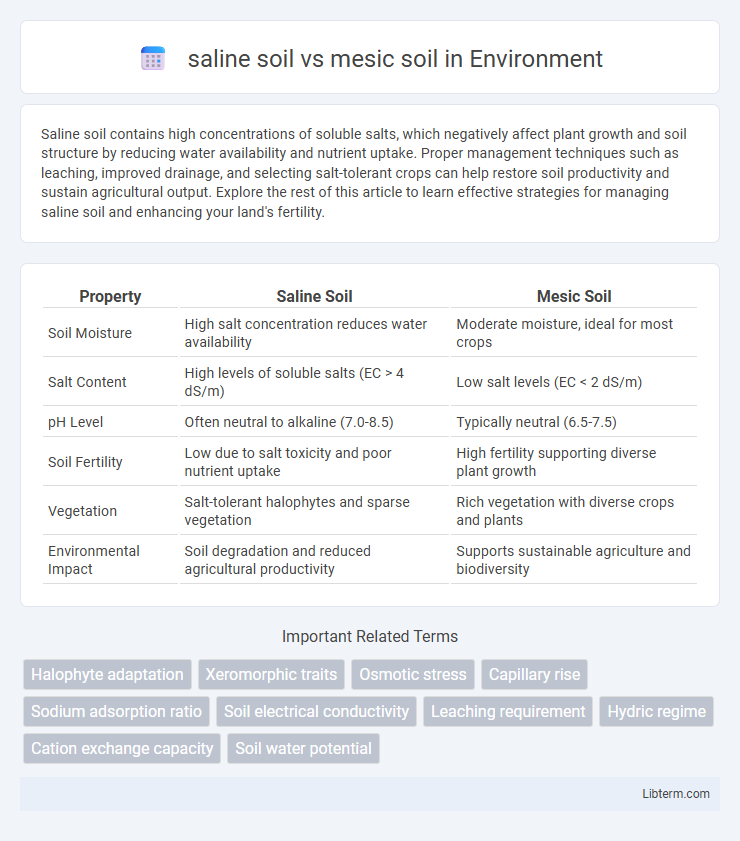Saline soil contains high concentrations of soluble salts, which negatively affect plant growth and soil structure by reducing water availability and nutrient uptake. Proper management techniques such as leaching, improved drainage, and selecting salt-tolerant crops can help restore soil productivity and sustain agricultural output. Explore the rest of this article to learn effective strategies for managing saline soil and enhancing your land's fertility.
Table of Comparison
| Property | Saline Soil | Mesic Soil |
|---|---|---|
| Soil Moisture | High salt concentration reduces water availability | Moderate moisture, ideal for most crops |
| Salt Content | High levels of soluble salts (EC > 4 dS/m) | Low salt levels (EC < 2 dS/m) |
| pH Level | Often neutral to alkaline (7.0-8.5) | Typically neutral (6.5-7.5) |
| Soil Fertility | Low due to salt toxicity and poor nutrient uptake | High fertility supporting diverse plant growth |
| Vegetation | Salt-tolerant halophytes and sparse vegetation | Rich vegetation with diverse crops and plants |
| Environmental Impact | Soil degradation and reduced agricultural productivity | Supports sustainable agriculture and biodiversity |
Understanding Saline Soil: Definition and Characteristics
Saline soil is characterized by high concentrations of soluble salts such as sodium chloride, calcium sulfate, and magnesium sulfate, which inhibit plant growth and reduce soil fertility. It commonly occurs in arid and semi-arid regions with poor drainage and excessive evaporation, leading to salt accumulation on the soil surface. In contrast, mesic soil maintains balanced moisture levels, supports diverse vegetation, and lacks the salt-induced stress found in saline soils.
Defining Mesic Soil and Its Key Features
Mesic soil is characterized by moderate moisture levels that support diverse plant communities without the extremes of dryness or saturation. Unlike saline soil, which contains high concentrations of soluble salts detrimental to most vegetation, mesic soil maintains balanced nutrient availability and favorable pH for optimal plant growth. This type of soil typically occurs in temperate climates and supports ecosystems with stable hydrological conditions and healthy microbial activity.
Causes and Formation of Saline Soils
Saline soils form primarily due to high concentrations of soluble salts like sodium chloride, often caused by factors such as poor drainage, high evaporation rates, and irrigation with salt-rich water. These salts accumulate in the root zone, disrupting plant water uptake and soil structure. In contrast, mesic soils develop in environments with moderate moisture availability, well-balanced nutrient content, and minimal salt accumulation, supporting healthier plant growth.
Natural Factors Shaping Mesic Soils
Mesic soils develop under moderate moisture conditions influenced primarily by climatic factors such as consistent precipitation and temperate temperatures, which promote balanced organic matter decomposition and nutrient cycling. These soils often form in regions with well-drained landscapes, supporting diverse plant communities that contribute to soil structure and fertility. In contrast to saline soils affected by high salt concentrations, mesic soils exhibit low salinity, ensuring optimal conditions for microbial activity and soil fauna diversity essential for ecosystem productivity.
Chemical Composition: Saline vs Mesic Soils
Saline soils are characterized by high concentrations of soluble salts such as sodium chloride, calcium sulfate, and magnesium sulfate, leading to elevated electrical conductivity and often causing osmotic stress to plants. In contrast, mesic soils exhibit balanced chemical composition with moderate nutrient availability and low salt content, supporting diverse microbial activity and healthy plant growth. The pH of saline soils tends to be alkaline due to sodium salts, whereas mesic soils usually maintain a neutral to slightly acidic pH conducive to nutrient uptake.
Impact on Plant Growth and Crop Selection
Saline soil, characterized by high salt concentrations, impairs plant growth by causing osmotic stress and ion toxicity, limiting water uptake and nutrient absorption. Mesic soil maintains balanced moisture and nutrient levels, supporting healthy root development and optimal crop yields. Crop selection for saline soils favors salt-tolerant species like barley and sugar beet, while mesic soils allow a wider range of crops, including maize, wheat, and vegetables, due to their favorable growing conditions.
Water Retention and Drainage Differences
Saline soil contains high concentrations of soluble salts, which reduce water retention by creating osmotic pressure that limits water availability to plants, leading to poor soil moisture retention despite adequate watering. In contrast, mesic soil has balanced moisture content with moderate organic matter, allowing efficient water retention and drainage suitable for diverse plant growth. Drainage in saline soils often becomes compacted and less permeable due to salt-induced soil structure degradation, whereas mesic soils typically exhibit well-structured pores facilitating consistent water movement and aeration.
Soil Management Practices for Saline and Mesic Soils
Soil management practices for saline soils emphasize leaching excess salts through proper irrigation and improving drainage to prevent salt accumulation, while incorporating salt-tolerant crop varieties enhances productivity. Mesic soil management focuses on maintaining optimal moisture through balanced irrigation, organic matter addition, and erosion control to support nutrient availability and soil structure. Both soil types benefit from regular soil testing to monitor salinity and moisture levels, guiding precise amendments and crop selection.
Environmental Implications of Saline and Mesic Soils
Saline soils, characterized by high salt concentrations, often lead to reduced plant growth, increased soil erosion, and altered microbial activity, negatively impacting agricultural productivity and local ecosystems. Mesic soils, with moderate moisture and nutrient levels, typically support diverse vegetation and enhance carbon sequestration, contributing positively to ecosystem stability and biodiversity. The environmental implications of saline soils include increased salinization risks and habitat degradation, whereas mesic soils promote sustainable land use and improved soil health.
Future Trends and Research in Soil Type Adaptation
Emerging research focuses on developing salt-tolerant crop varieties and regenerative practices to enhance saline soil productivity while preserving mesic soil biodiversity and moisture retention. Advances in remote sensing and soil microbiome manipulation are driving precision agriculture tailored to specific soil types. Future trends emphasize integrated soil health monitoring and adaptive management strategies to mitigate climate change impacts on both saline and mesic ecosystems.
saline soil Infographic

 libterm.com
libterm.com